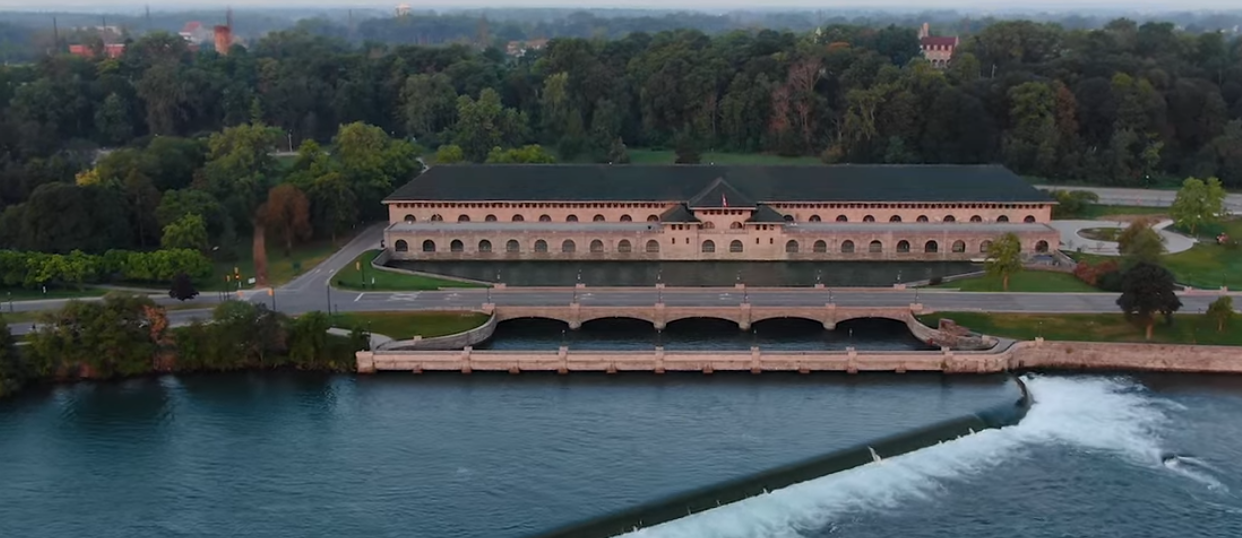 By Ray Rivers
By Ray Rivers
July 10th, 2022
BURLINGTON, ON
If there is anything certain in this very troubled world we live in, it’s that clean electricity is the future. Eventually it will replace every aspect of our lives that were once dominated by fossil fuels. And yet the history of electricity is relatively brief and the lessons not universally accepted.
Niagara Falls holds a special place for Canadians. It is the most popular tourist spot in the country, bringing in over 12 million tourists who spend more than $2 billion a year. And while there are the casinos and the tacky amusement arcade, it is the magnificent 167 foot high waterfall that tourists come to see.

This year the Niagara Parks Commission added an attraction, hoping to lure a thousand visitors a day. They opened up the 2200 foot water spillway tunnel in the historic power plant which takes visitors near the base of the falls. It is a view rivalling that of the ‘maid of the mist’ boats. Commissioned in 1906 the hydro power plant is now a museum and loaded with educational information about the role hydro electricity has played since its inception.
Not all water power projects are alike. The James Bay hydro project in Northern Quebec, poised to become the largest in the world, couldn’t be more different. Development of the Hydro Quebec project required flooding 11,500 square kilometres of wilderness, forcing thousands of indigenous James Bay Cree and Inuit out of their homes and villages.
Over 10,000 caribou were wiped out in the process. And even worse, flooded forest vegetation is now rotting, releasing mercury into the huge water reservoirs and making the fish inedible. The mercury is mostly a result of pollution from coal burnt in southern electricity plants and absorbed by the vegetation as it grew.
But no rivers were dammed at Niagara. As much as three quarters of the water exiting Lake Erie is now channelled to giant water turbines while the rest tumbles over the falls to entertain the tourists. And the good news – the diversion of water from the falls has been slowing down the rate of natural erosion, thus extending the life of the falls.

If you look closely to the centre left you can see the tunnel opening where the water is returned to the River.
Ontario gets about a quarter of its electricity from hydro power sources and Niagara is a major contributor to that. The demand for electricity is expected to increase as our population grows and as society converts from its current fleet of gas guzzlers and fossil fuel space heating. But there are few opportunities for clean water power left in Ontario.
Burning coal or gas for electricity production in Ontario never really made sense for a province with neither coal mines nor significant gas production. That was the case even before we understood the dangers of smog, acid rain and climate change. Nuclear energy allowed the province to get off coal and it currently supplies over half of the province’s electricity. But getting to reliability for the nuclear power facilities has been a long, costly and problem-plagued pathway.
New nuclear development, even with small modular reactors, is both costly and could take years to become operational. Recent research indicates that, though smaller in size and output, the new proposed small nuclear reactors (SMR) generate more nuclear waste per kilowatt hour than the larger heavy water facilities they’re intended to replace. The elephant in the room is the disposal of nuclear waste. Nobody anywhere has a viable solution to the steadily accumulating waste. Currently there are over three million highly radioactive spent fuel bundles lying in swimming pools, as ‘temporary’ storage.
In many ways the closest relative to that Niagara Falls water turbine is the wind turbine. Excepting solar energy and the emerging potential for green hydrogen, wind is the safest and cleanest form of renewable energy. Wind towers are relatively low cost, can be located easily, and produce significant amounts of energy depending on the blow, obviously. Wind towers have been blamed for occasional bird and bat collision deaths, though nothing compared to office towers, oil spills and mostly domestic cats. And even water power ends up killing some fish.
Wind power development in Ontario grew rapidly from nothing at the beginning of the millennium to about 8% by 2018 before the Ford government killed new renewable energy projects. Germany, by comparison, is planning to be 80% reliant on renewable energy by 2030. In the first quarter of this year Germans are already producing half of its electricity with renewables, the bulk of that being wind power, a source which has more than trebled over the last decade.

A glass walled elevator drops to the bottom of the power station where it returns to the Niagara River.
Doug Ford has reversed Ontario’s leadership in combating climate change, embracing fossil fuels in lieu of renewable energy. The Province has invested $3 billion for gas plants during his first term. Mr. Ford’s opposition to renewable energy can only be described as ideological because it is certainly not economically rational. Wind and solar, not gas, are the least costly means of increasing Ontario’s electricity supply.
And it is shortsighted since the province will need substantially more electricity to accommodate the conversion from fossil fuels, be it space heating, electric vehicles or new industrial investment in the face of federal restrictions on greenhouse gas emitting sources. For example, Ontario is losing the proposed $2.5 B Windsor battery maker LG Chem because the government could not guarantee electricity supply. Ontario may claim to be open for business, but not if business requires electricity.
That old power plant at Niagara Falls is a learning centre with many lessons for all of us. Using renewable energy is one of them. As Mr. Ford embarks on his next four year mandate to govern the province, he would do well to take direction from that piece of valuable history.
The Gazette will be doing a feature story on the Power Plant – it is a truly amazing site – well worth a visit.
 Ray Rivers, a Gazette Contributing Editor, writes regularly applying his more than 25 years as a federal bureaucrat to his thinking. Rivers was once a candidate for provincial office in Burlington. He was the founder of the Burlington citizen committee on sustainability at a time when climate warming was a hotly debated subject. Ray has a post graduate degree in economics that he earned at the University of Ottawa. Tweet @rayzrivers
Ray Rivers, a Gazette Contributing Editor, writes regularly applying his more than 25 years as a federal bureaucrat to his thinking. Rivers was once a candidate for provincial office in Burlington. He was the founder of the Burlington citizen committee on sustainability at a time when climate warming was a hotly debated subject. Ray has a post graduate degree in economics that he earned at the University of Ottawa. Tweet @rayzrivers















Well-written and interesting. Do they have tours of the power-generating plant? the place looks like.
Editor’s note: Yes they do and it is well worth a visit. We will be doing a piece on what
Even at my age this post stimulated in me a desire to revisit this marvelous area. In remembering my childhood visit I had memories of the steady and forceful wind associated with the falls. So, in the context of the post I am wondering whether placement of large wind turbines, such as one sees on roofs only much larger, would be a practical way to enhance power generation. I think it could be done in a way that does not affect the view of the site.
Speaking of view, perhaps it’s time we begin to see efficiency as pleasing to the eye as well as to the pocketbook.
And we still elected him, feel sorry for the Province